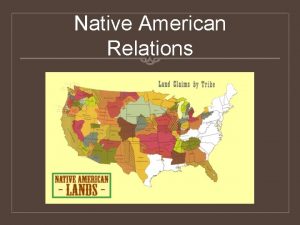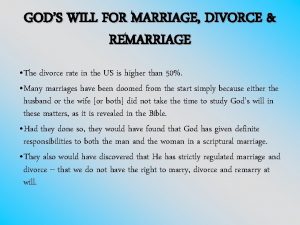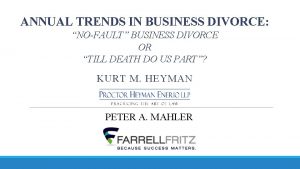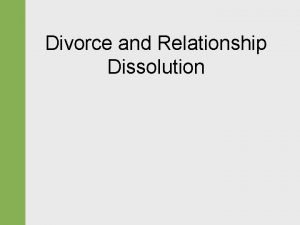DIVORCE DIVORCE TRENDS AMERICANS LIKE MARRIAGE One of























- Slides: 23

DIVORCE

DIVORCE TRENDS • AMERICANS LIKE MARRIAGE: One of highest marriage rates in industrialized world. • AMERICANS DON’T LIKE MARRIAGE: One of the highest divorce rates in world. • AMERICANS LIKE MARRIAGE: One of the highest remarriage rates in the world (1/3 remarry within a year).

50% • 50% of all marriages are likely to end in Divorce. • By 1974 more marriages ended in divorce than by death.

WHAT IS THE PROBLEM HERE? Discuss: 1. When people get married today they don’t need to make a commitment because it is so easy to get a divorce. 2. Social scientists are increasingly viewing divorce as one path in the “normal” family life cycle. 3. Is falling out of love an appropriate reason for wanting a divorce? What is? 4. Is divorce the problem or is it a solution to other problems? 5. Death is easier for children to accept than divorce.

COHABITATION MYTH: Living together improves chances for a successful marriage. FACT: Couples who cohabit have higher divorce rates than couples who do not. MYTH: “If we live together, we’ll get married sooner. ” FACT: Living together delays long-term commitment.

HOW CAN WE PREVENT DIVORCE? • Make getting out of marriage more difficult? It used to be hard with a reason. • Encourage women to stay home with children so they can’t afford to get out? (Large contributor to likelihood of divorce. ) • Encourage family & self sacrifice and less selffulfillment? • Impose more religious constraints? • Should we re-stigmatize divorce?

FACTORS AFFECTING DIVORCE • The shift from agriculture to industrialization undermined many of the families traditional functions. • Social integration – the degree of interaction between individuals. • America emphasizes individualism and this can take priority over family.

FACTORS LEADING TO DIVORCE • The most common cause of divorce is selfishness. • It could be selfishness with time, money, work, caring and communication. • Other factors of divorce may be changing value system, physical and emotional abuse, religious differences or alcohol/substance abuse.

DEMOGRAPHIC FACTORS AFFECTING DIVORCE: WHO IS MORE LIKELY TO DIVORCE? • Low • High or low income? • Woman has the higher or lower • Higher income? • Low • High or low education? • More or less religion? • Less • Religion? (Jewish, Catholic, • Protestant) • Race? (white, African American or Hispanic) • African American • Younger or older at time of • Younger marriage? • Second • 1 st or 2 nd marriage? • Parents married or divorced? • Divorced

ASPECTS OF LIFE AFFECTING DIVORCE: • Adolescent marriages = twice the likelihood of divorce • Premarital pregnancy does not significantly increase likelihood of divorce. • But it increases if she; • is an adolescent. • drops out of high school. • faces economic problems.

THE ACTUAL DAY-TO-DAY FAMILY PROCESSES MAY BE THE MOST IMPORTANT FACTOR In descending order: (first one is more likely) • Personality problems • Home life • Authoritarianism • Differing values Majority of divorce is caused by the idealization of marriage. Must realize marriage is like LIFE – it is a lifelong commitment involving considerable sacrifice. It is hard and has many problems.

PULLING APART IN STAGES: • Isolation— Partners withdraw emotionally and no longer share intimacy • Invalidation— Partners respond negatively to each other; such as accusing and belittling • Betrayal— Trust is broken and support is absent

HOW MARRIAGES ARE ENDED • Annulment • Legal Separation • Divorce

ANNULMENT • State that a legal marriage never took place. • Must involve a lawyer and religious leader.

LEGAL SEPARATION • The grounds for legal separation (separation from bed and board) in North Dakota divorce law are: (1) irreconcilable differences; (2) adultery; (3) confinement for incurable insanity for a period of 5 years; (4) conviction of a felony; 5) willful desertion; (6) cruel and inhuman treatment; (7) willful neglect; (8) habitual intemperance (drunkenness). The spouse filing for legal separation must be a resident of North Dakota for at least 6 months prior to the entry of the legal separation or commencement of the action.

DIVORCE PROCESS Not a single event but a complex process Do you see a judge? Do you go to trial? • Attorneys never work to reconcile a divorcing couple – • 90% are NO CONTEST No Fault Divorce (irreconcilable differences, neither party responsible) • Cost?

NO FAULT DIVORCE • • • All 50 states have adopted “No Fault Divorce” No one is guilty No adversary process Settlements are based on equity and need Promotes gender equality Who might be at a disadvantage due to “No Fault Divorce”?

ND GROUNDS FOR DIVORCE • A divorce may be granted in North Dakota divorce law for either no-fault or fault grounds. • The sole no-fault ground is irreconcilable differences. • Annulment

ND GROUNDS FOR DIVORCE • Fault grounds include: (1) adultery; (2) confinement for incurable insanity for a period of 5 years; (3) conviction of a felony; (4) willful desertion; (5) cruel and inhuman treatment; (6) willful neglect; (7) habitual intemperance (drunkenness). • .

ATTITUDES ABOUT DIVORCE What is your opinion about: • Staying married for the sake of the children • Impact of divorce on children • Single parenting • Children living between two households • Child support • Alimony • Remarriage • Being a stepmother/stepfather

DONE

MARITAL SEPARATION **A more crucial event than the divorce 1. SEPARATION DISTRESS: Situational anxiety caused by separation from an attachment figure. • 2 nd only to death of a spouse • All attentions are centered on spouse with feelings of anxiety & fear • Sometimes immediate effect of separation is euphoria, but usually slips into separation anxiety • Slowly gives way to loneliness

MARITAL SEPARATION 2. UNCOUPLING: a quiet detachment of one of the spouses 3. NEW SELF: Post-divorce identity has two stages: • The transition period with separation distress and loneliness. • The recovery period with stable life and less emotion.
 Marriage and divorce presentation
Marriage and divorce presentation Most americans can speak only one
Most americans can speak only one Hypergamous marriage
Hypergamous marriage Becoming one intimacy in marriage
Becoming one intimacy in marriage One god one empire one religion
One god one empire one religion One one one little dog run
One one one little dog run One king one law one faith
One king one law one faith One god one empire one emperor
One god one empire one emperor Ford one plan
Ford one plan See one do one teach one
See one do one teach one See one, do one, teach one
See one, do one, teach one Twelfth night speeches
Twelfth night speeches See one do one teach one
See one do one teach one One vision one identity one community
One vision one identity one community Graphic organizer with the aims of la liga filipina
Graphic organizer with the aims of la liga filipina Chapter 1 history and trends of healthcare
Chapter 1 history and trends of healthcare What did americans underestimate in their eagerness for war
What did americans underestimate in their eagerness for war Gettysburg
Gettysburg Where did native americans come from
Where did native americans come from Where did native americans come from
Where did native americans come from How many native americans died on the trail of tears
How many native americans died on the trail of tears Napkin british english
Napkin british english British and american word differences
British and american word differences American struggle with postwar issues
American struggle with postwar issues













































